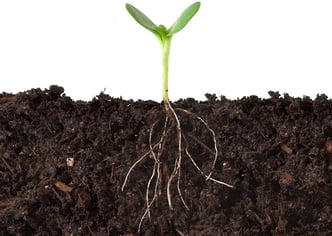By Maud Hinchee, PhD, Chief Science Officer, Agricen Sciences
 It’s spring, and newly germinated seedlings are revving their engines!
It’s spring, and newly germinated seedlings are revving their engines!
Once a seedling has secured a foothold with its root, it uses the power of its photosynthetic engines to drive growth. Sunlight is the fuel source, enabling the plant to produce the proteins, lipids and carbohydrates it needs to make new leaves and new roots. To create these internal building blocks, the seedling must mine and extract raw materials from the soil in the form of water, macronutrients and micronutrients.
How does a root prospect? Unlike the “49ers” who picked up their stakes and often travelled great distances to join the California Gold Rush, a plant is literally rooted to its home. Often, its immediate home is not choice real estate with plentiful water and nutrients on tap, so the plant needs to be able to find water and nutrients, sometimes at great distance, and “sluice” them back through its root system to the growing shoot.
Crop plants are lucky, as growers work to ensure that the necessary nutrients, especially nitrogen and phosphorus, are available for their germinating seeds through careful fertilization. However, added nutrients are not necessarily distributed evenly in the soil. Nitrogen, typically applied as nitrate or ammonia, tends to move relatively easily and homogenously down through the soil, while phosphorus tends to be bound up quickly with metals and is typically found in patches nearer to the soil surface.
The most productive plants are ones that can efficiently find and utilize nutrients – no matter where they might be distributed in the soil – by “sniffing” them out with their growing root tip, which has nutrient receptors that function similarly to the receptors found in our nose. These receptors can sense whether or not a nutrient is present. If a root perceives a low or high concentration of a nutrient, it responds by changing its nutrient mining strategy.
If the seedling’s growing primary root senses a low quantity of phosphorus, the seedling shifts its nutrient excavation strategy. It slows its primary root growth and produces a higher density of long, lateral roots that can better prospect for bioavailable phosphorus typically found in the topsoil. If a lucky lateral root finds a rich pocket of bioavailable phosphorus, then additional root proliferation and root hair formation may occur to fully mine that motherlode.
In the case of nitrogen, which tends to be distributed more deeply and homogenously in the soil, the primary root continues to drive down into the soil, producing lateral roots that are relatively evenly distributed along its length. If the root senses that nitrogen levels are becoming low, then it devotes energy to lateral root growth to increase its access to larger soil volumes.
The root system doesn't find its nutrients by chance! As the seedling journeys towards its ultimate goal of reproducing, it actively modifies its root system to best drill into a rich vein of water or nutrients.
Growers can help, too, by using biocatalyst technologies that increase root mass and enhance root development, allowing plants to better mine the nutrients they need to grow and yield optimally.
Learn more about biocatalyst technologies by browsing Agricen's collection of resources, which includes product studies, videos and publications.







